Before the international fixtures, there was a top-table clash in Allsvenskan. Malmo FF stayed at the Stadion and welcomed Elfsborg as the visitors, looking to extend their seven-point margin. The away side was the only team that have beat the league leaders this season, they would definitely want the same results.
In this tactical analysis, I am dissecting both sides’ tactics used in the clash. Jon Dahl Tomasson and Jimmy Dahlin have interesting ideas that were implemented into this game.
Lineups
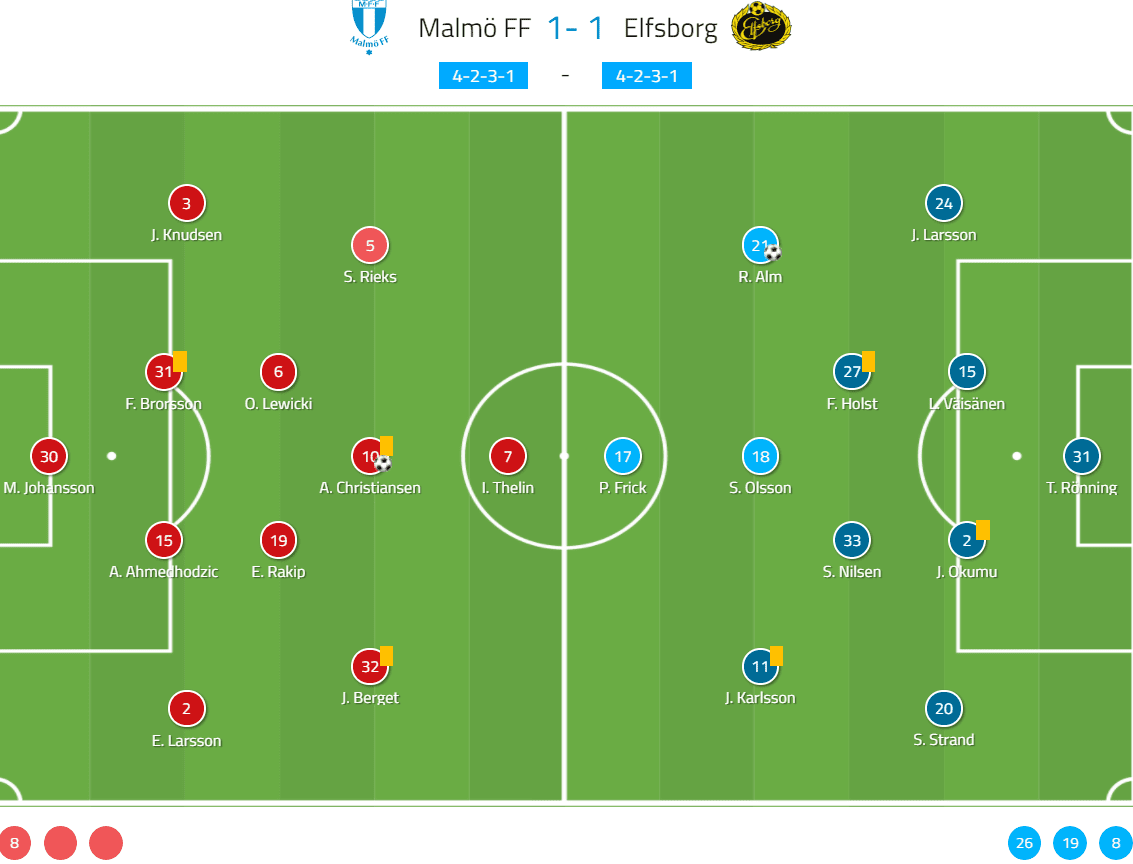
The home side was playing in a 4-2-3-1, this was the exact formation that triumphed in the UEFA Europa League Qualifying. Still, they were without the former Toulouse striker – Ola Toivonen. Meanwhile, Fouad Bachirou has left the team and joined Nottingham Forest.
The away team started the strongest possible squad, also in a 4-2-3-1. They have not won the last two game. Rami Kaib was suspended, hence, Thelin played Simon Strand as the left-back. Another change was at the striker position, Per Frick returned, replaced Marokhy Nidone.
Malmö breaking the press
Before investigating the offensive tactics of the home side, we should understand how the Elfsborg defended so to identify the task. Di Gule were pressing in a zonally with a shape similar to their 4-2-3-1 on paper. In the first 15-20 mins, the high press began from the goal kicks and caught Malmö in the offensive third a few times.
A very strong pressing trap was set on the right-back, Eric Larsson. A prerequisite was to guide the ball into either half, especially in cases that Marko Johansson played the ball to either centre-back. They have more control on pressing Malmö’s right flank, the trigger was the moment that Anel Ahmedhodžić passing the ball to E. Larsson.
However, the winger should stay at the half-spaces initially instead of sticking to the full-back. This was a strategy that tries to nullify the impact of Jo Inge Berget, a winger that likes to drop. The passing lane should be cut, or else the left-back would have to deal with the winger in large spaces.
Below is the example of the press, Elfsborg were shifting to either vertical half to reduce the area to defend. E. Larsson was forced to play a difficult pass, allowing the Di Gule centre-backs to read and win the ball back.
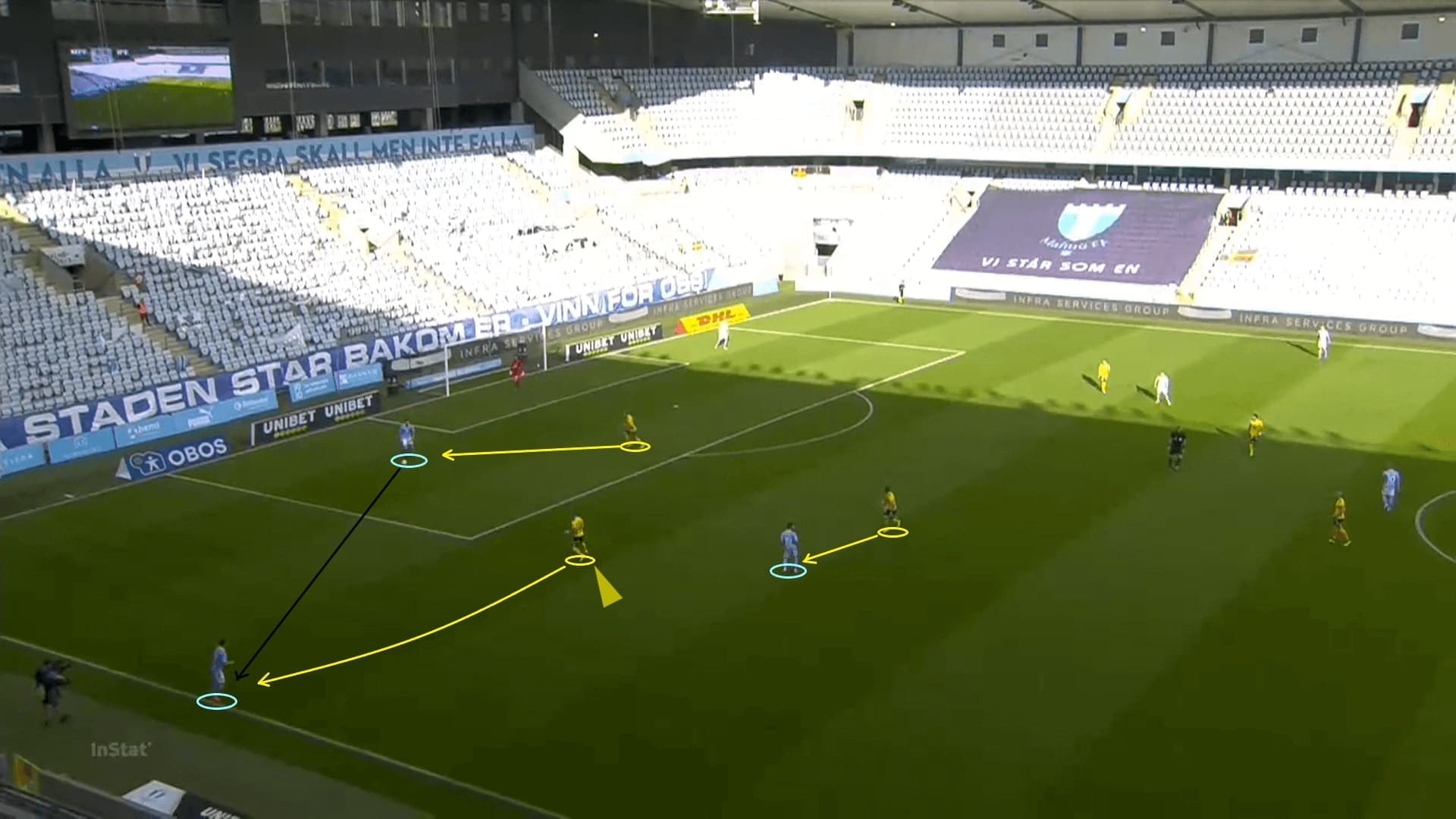
Full of pressing traps on Malmö’s right flank. Sometimes the attack did not begin from a goal kick, the above strategy could not be replicated in 100%. However, some features remained the same to minimize the impact of the attack – Strand must get very tight on Inge Berget, even sticking with his back to prevent the Norwegian winger from turning.
Given the system was a zonal one as explained, the moment that Ahmedhodžić passed the ball, players were surrounding the receiver simultaneously. The habit of Inge Berget – closing his body when dropping was never conducive to advance the ball into higher areas on the pitch. In these cases, Elfsborg were able to trap the winger and win the ball back.
The verticality allowed teams to use third-man plays offensively, but Malmö could not do this because of the relatively flat midfield. No viable third man even the ball reached Inge Berget on the right.
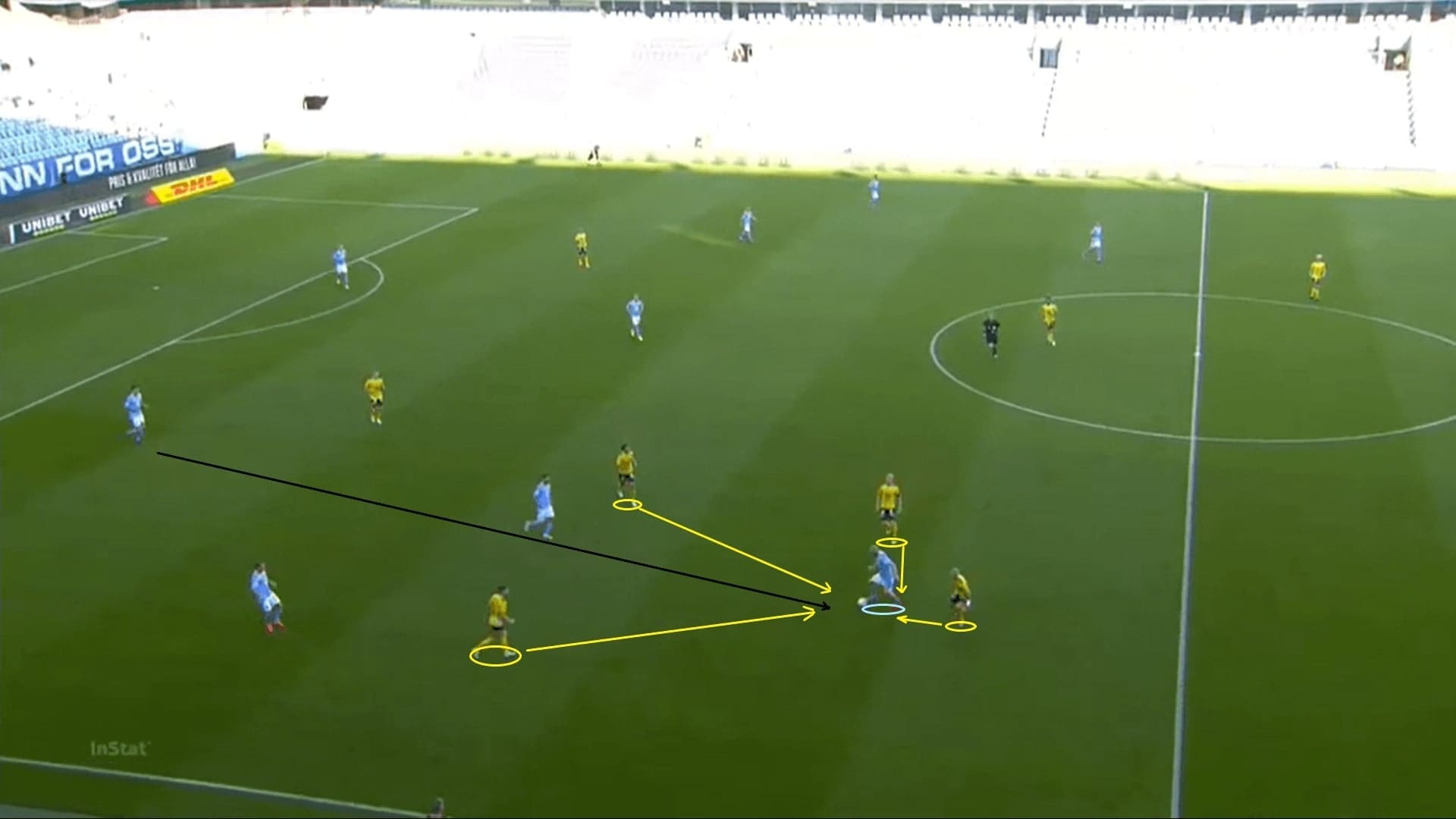
However, the context was very different on the left, as Malmö enjoyed playing out from this side. It was because of Christiansen’s impact, the skipper often dropped to this vertical half to add an extra man in the build-up. Also, Søren Rieks played as the false wingers, interchanging positions with teammates, leading to a strong dynamic to disguise the opponent.
Di blåe have more successful cases to advance through the left vertical half. Here, Rieks cleverly exchanged position with Christiansen, who was dropping. This created a temporary 2 v 1 on the midfielder, while Johan Larsson was not sure about who to follow. When Christiansen arrived on the same line of the Elfsborg winger, attention was drawn, leaving Jonas Knudsen as a free option as a second. While the dropping of Christiansen also delayed the timing for the midfielder to track Rieks.
Another positive factor was the support offered at the centre. When Isaac Kiese Thelin occupied the centre-back(s), Inge Berget and Erdal Rakip were alert to exploit spaces opened at the centre (zone 8 and zone 11). Just like the example below, the home side could play the ball out of the pressure zone and attack the weak side of the opponent, reaching the offensive third in an instant.
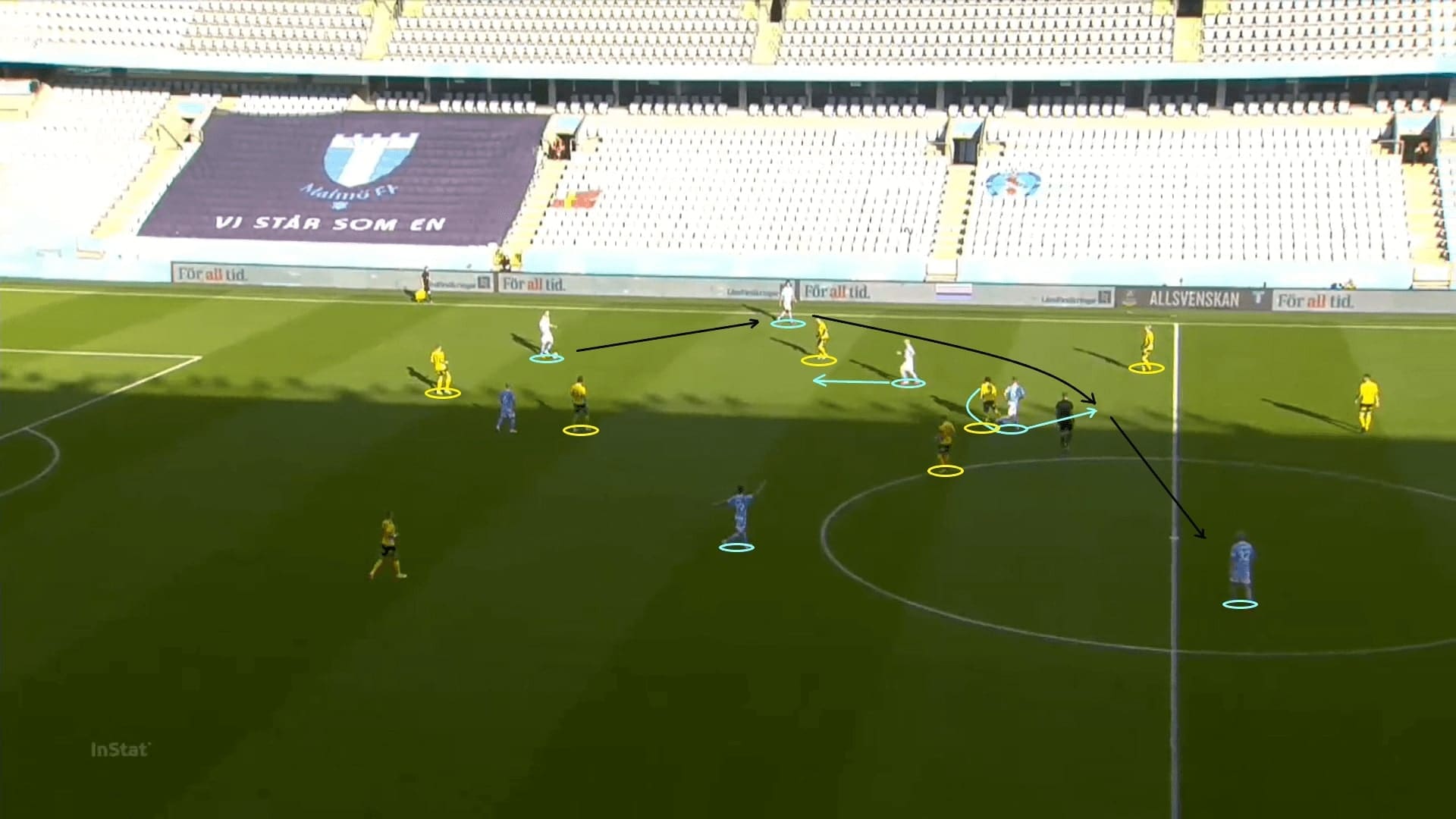
Given the tendency of Christiansen dropping to the left, free man was created in that zone. Sometimes Malmö did not even need Christiansen, since dropping Oscar Lewicki to the half-spaces and push Knudsen high was enough to disguise the opponent. In these cases, Knudsen could draw the attention of the right-back and the midfielder, as the below image has demonstrated.
Again, the inside-out run from wingers was exploiting the blindside of the defence, is a free option to receive the ball behind the right-black.
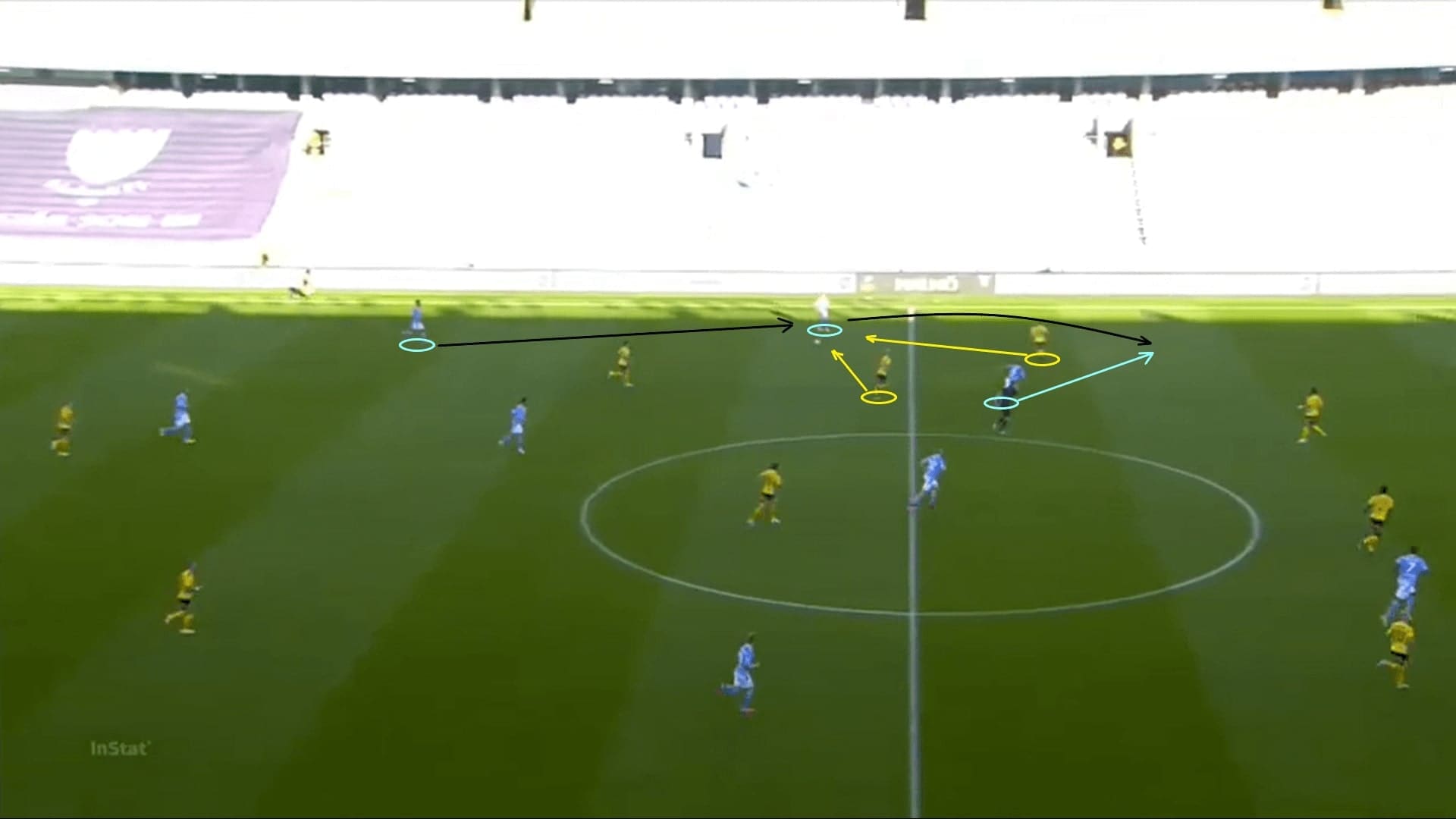
From a tactical standpoint, the impact of Malmö’s false wingers was huge and overloaded the zonal system of Elfsborg. It was because of the manipulation of the midfield, as Di blåe have around four players (“AC”, Rieks, Inge Berget and Rakip) against the midfield trio of the opponent. Meanwhile, the full-backs have to remain in the wide zones to stretch the opponent wingers, ensuring this numerical imbalance at the centre.
In the second half, Christiansen dropped even deeper to push Lewicki to the wide zone, Knudsen higher up on the pitch.
The dilemma of Elfsborg was that they could not cover all options in the midfield. There was an extremely fluid move near the hour mark that Di blåe using build-up to reach the final third. This was not only generating multiple options for the Dane midfielder, but also removing pressure as the opponent tended to cover the players at Malmö’s third line.
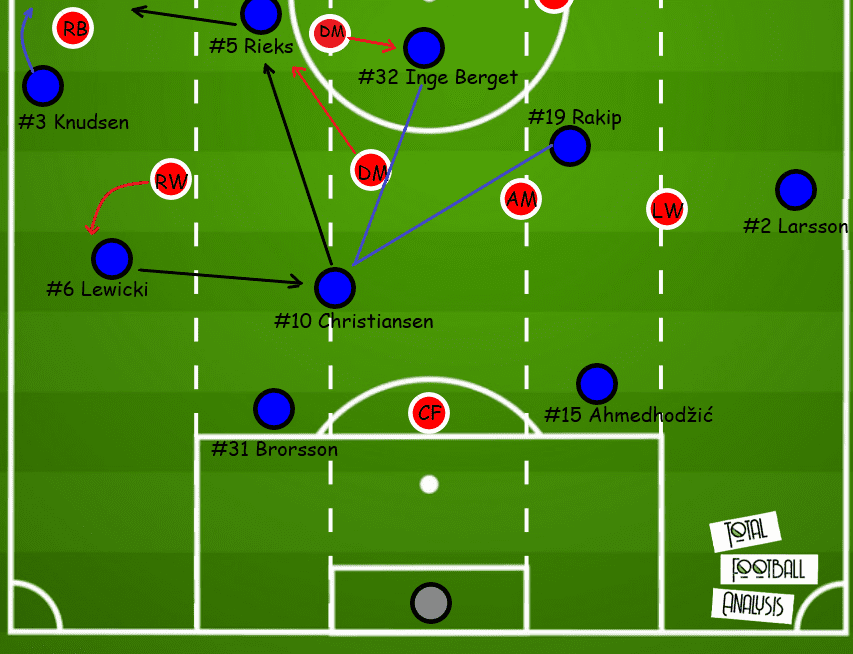
Also, Elfsborg’s defence could not match the same intensity as they did in the first half. The game was more opened and more chaotic in the second half. Di Gule more often set a midblock at the midfield, in a 4-2-3-1 shape. Using a similar concept, when Rieks and Inge Berget could occupy the opposition defensive midfielders, while Christiansen operating as the free player in this zone.
When Di Gule were not pressing the ball, Ahmedhodžić could fully exercise his ball-playing ability, connecting teammates between the lines. We have seen more cases involving Toivonen before, but only Christiansen was available today, he was the man to receive the ball below.
Credits should be given to Kiese Thelin also, the former Bayer Leverkusen striker did a great job in occupying the centre-backs throughout the game. For example, neither Joseph Okumu nor Leo Väisänen should step out to press Christiansen because of Kiese Thelin’s good positioning. The striker utilized positional superiority to limit the defensive coverage of the opponent.
Also, Strand was affected by Inge Berget too much because of the instruction as explained. There were many cases that Malmö attacked spaces behind the left-back after Strand was pulled out, several crosses also came from that flank.
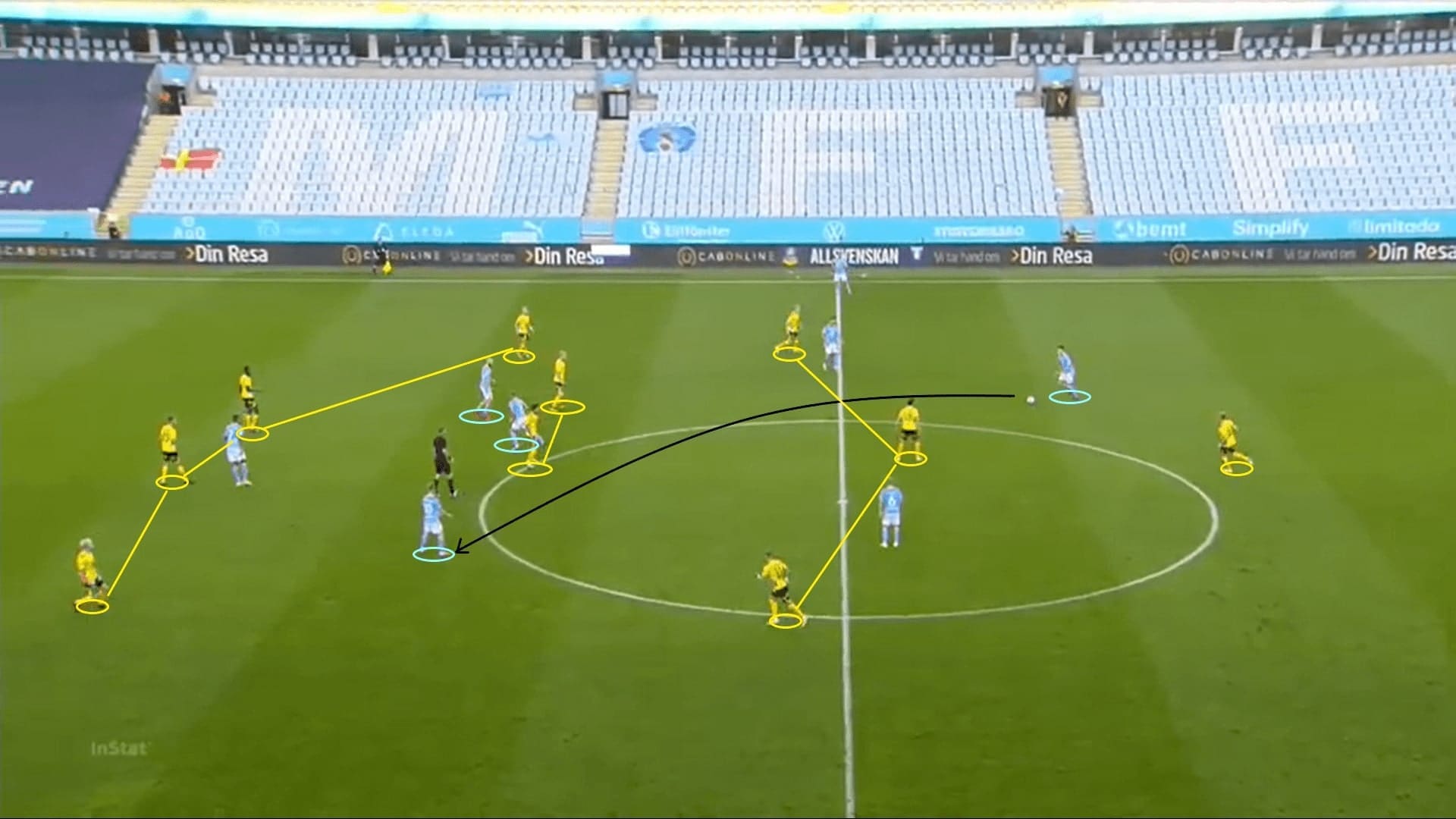
Elfsborg attacking half-spaces
Contrasting to Elfsborg’s defensive scheme, Malmö used a passing-lane oriented press, pushing Christiansen to join Kiese Thelin at the first line, it was more like a 4-4-2 shape. The backline more often staying on the same horizontal zone near the halfway line. However, the press was not aggressive enough, the highest line was late on the opponent. Instead of attacking the ball, Malmö players were more aware of the opponents behind, hence, this gave Elfsborg the opportunity to escape from the press.
The best pressing scenarios and triggers were the return passes to Tim Rönning. It seems the 21-year-old keeper was not comfortable on the ball, hence, tended to misplace passes under pressure. On average, the passing accuracy of Rönning is 83.4%, but this game was only 74% because of confronting the high press.
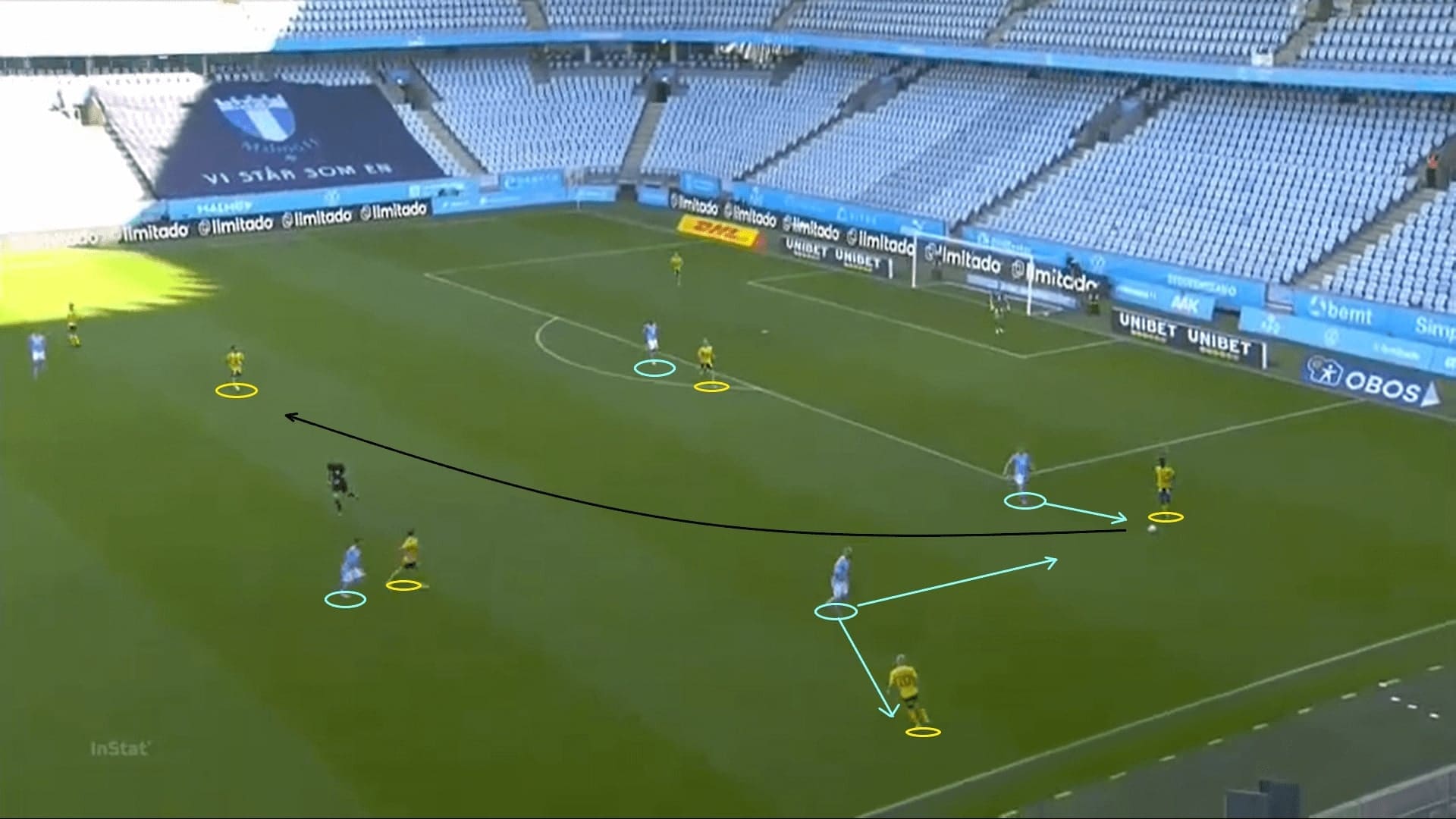
The likes of Okumu and Väisänen might have caught Malmö by surprises with some difficult passes, such as diagonal balls or passes going to the reversed directions. In general, the average long passes % of Di Gule is 17.54%, but the figure has risen to 23.62% at the Stadion.
Okumu, individually, had a nice game, just like the first clash months earlier. He provided 15 long passes and completed 10 of them, the success rate was 66.67%, quite high indeed. Some of his passes were difficult to achieve because of the angle being pressed, but there were cases that Elfsborg reached the attacking half thanks to Okumu.
Another feature of Elfsborg in this game was the dropping of front players. The attack was not about the build-up shape, but to effectively hit spaces and find the right player. By dropping between the lines and the good passes from the centre-backs, Elfsborg might directly evade the pressing players and face the backline.
As an example, Okumu found the dropping player, who could turn easily and dribble forward.
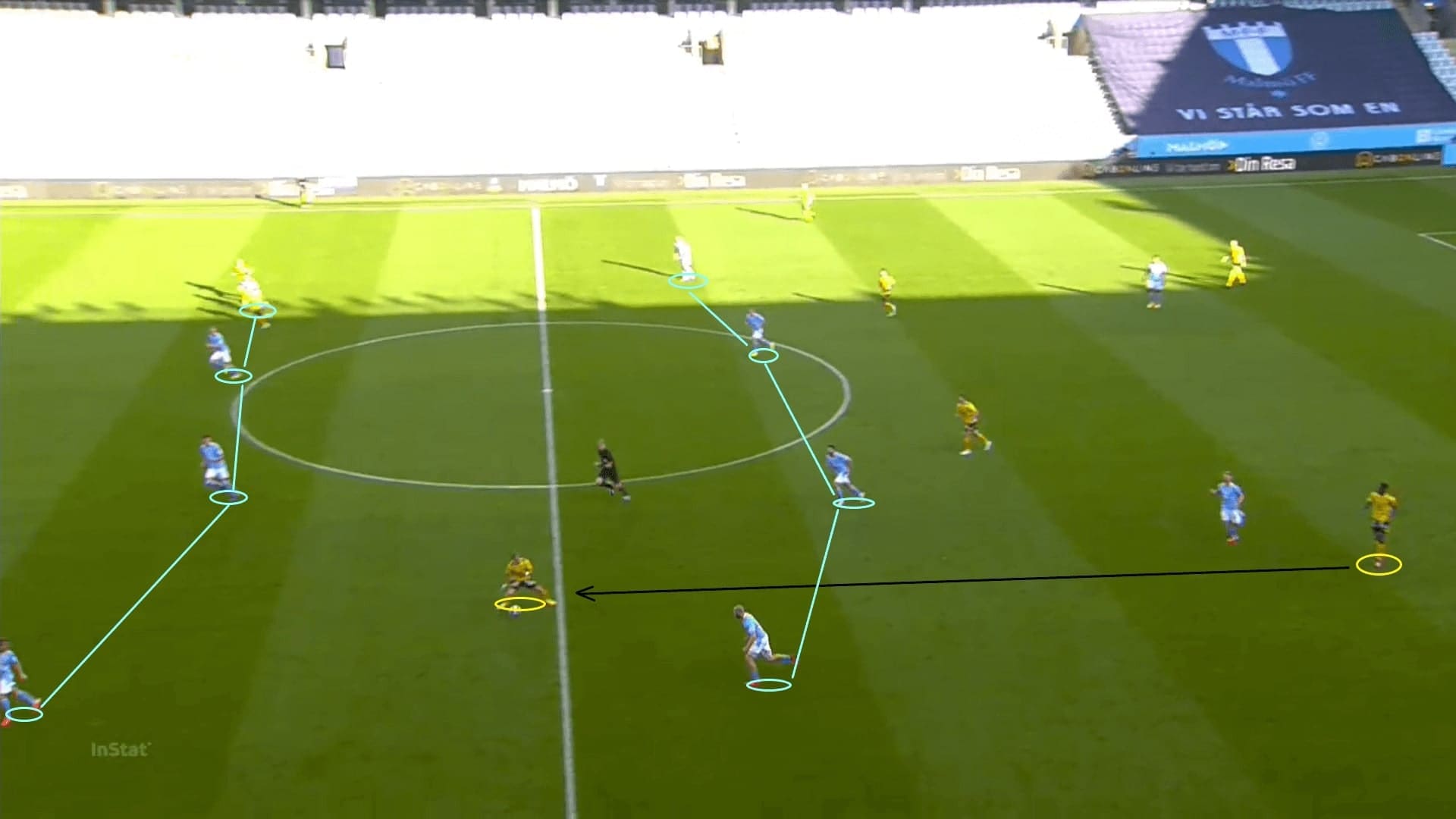
The dropping movements of Elfsborg players were dangerous and difficult for Malmö to deal with. In this example, the right-winger came to deep and pulled Knudsen out of position. This opened spaces on the right for J. Larsson to attack, and it was too late for Rieks to react.
Another point to note was the double-overload on E. Larsson on the far side, this was another key area that Elfsborg identified to attack. In general, the high line of Malmö was being exploited by these long passes or diagonal passes.
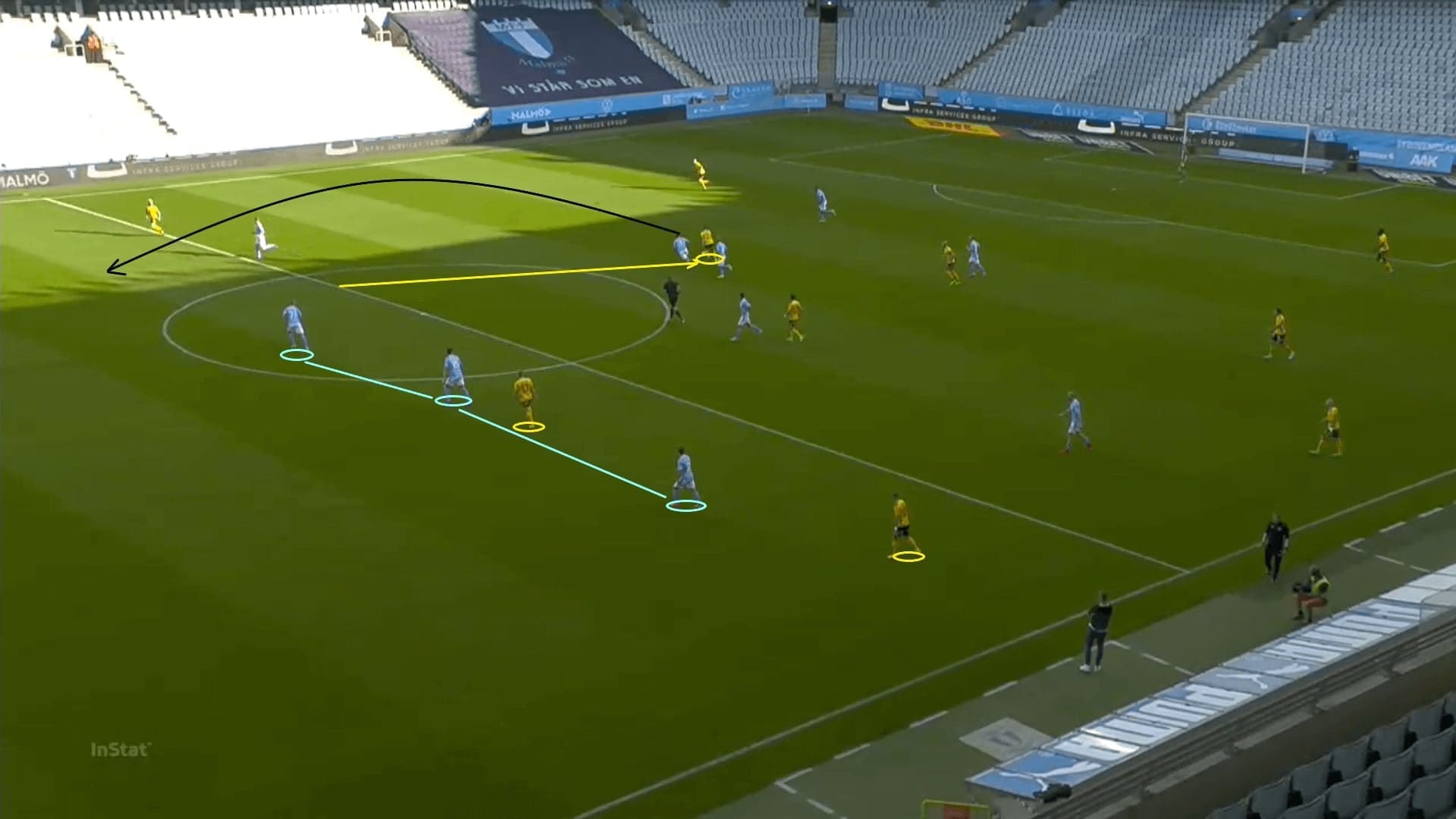
It seems Ahmedhodžić was more conservative in terms of leaving his position to press in this game. On the contrary, Franz Brorsson and Knudsen were more likely to follow the dropping player. In another case, the dropping player caught the attention of the centre-backs, while the real target – Jesper Karlsson made his run at the relative half-spaces. Given the high line of Malmö, there were too many spaces to exploit, which has eventually led to the goal of Rasmus Alm.
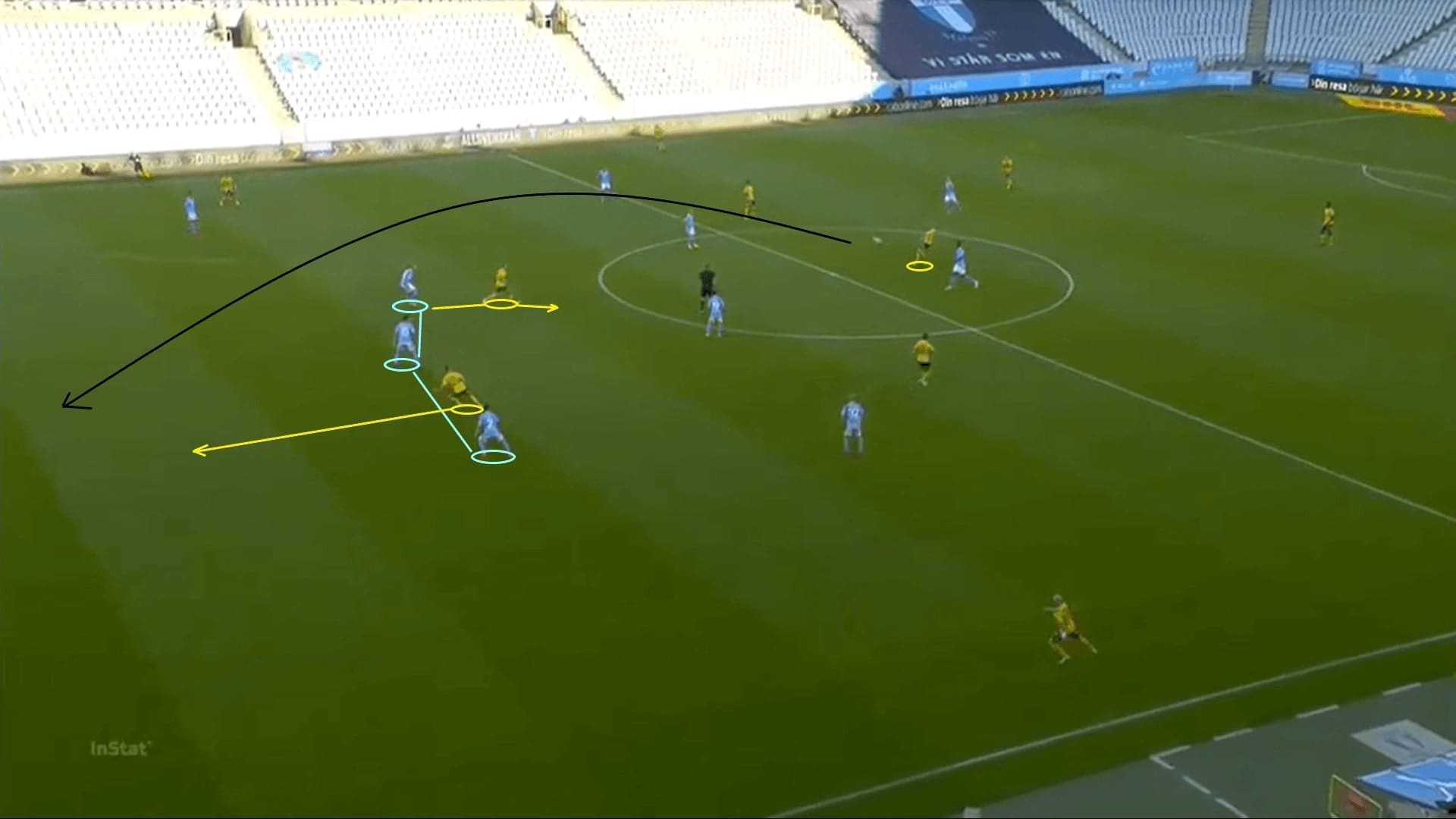
Another area that Elfsborg hit Malmö a lot were the flanks. Di blåe were not putting real pressure on the ball even the opponent was dribbling at the flank. Some were developed into the crosses.
Usual stuff – Elfsborg attacked with a pair of offensive full-backs. Strand and J. Larsson could attack the penalty box while another of them might be whipping the cross. Including the wingers and strikers, Di Gule at least as three to five players attacking the penalty box during the crosses. On occasions, the far post was overloaded, and it was difficult for Di blåe to defend. Elfsborg players were going to different directions, it was uneasy to track.
For example, Strand attacked depth below, while Frick and Alm were going to the penalty spot, successfully headed the ball.
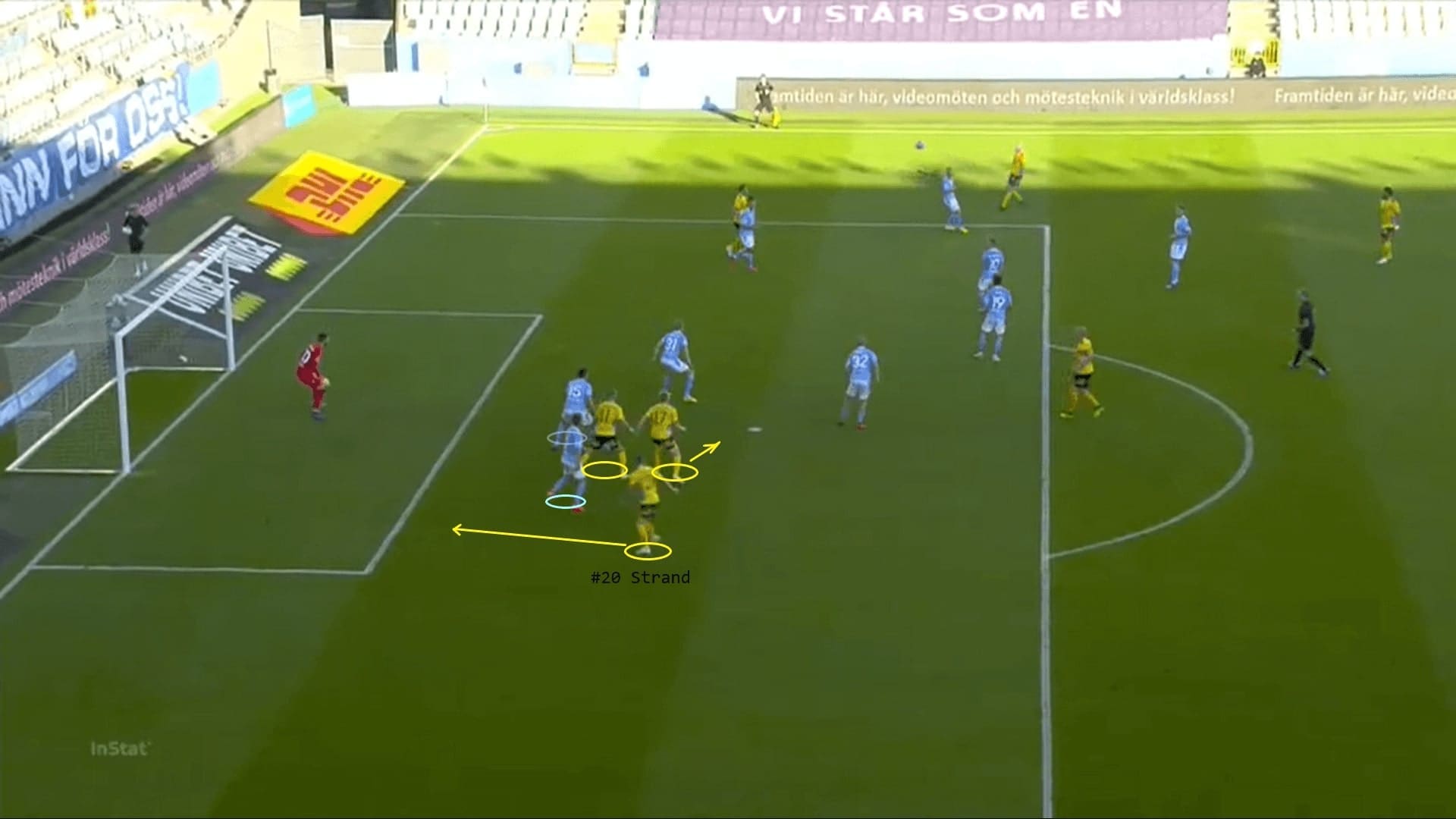
However, the team might need better deliveries to create more high-quality chances. Despite forcing Johansson to make a good save at the 40th minute, the deliveries were not accurate enough to fully utilize the dynamics inside the penalty box.
The below graph was the crossing graph of Elfsborg, the full-backs – J. Larsson and Strand were joint second crosser of the team. The success rate was only 25% – only three of twelve crosses were able to find the target. Meanwhile, the season average was 33.4%.
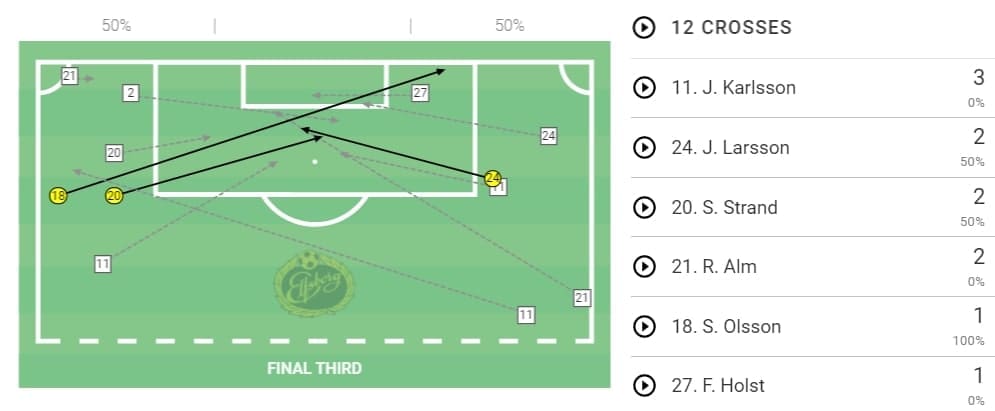
In addition, Elfsborg attacked the half-spaces a lot on E. Larsson’s side. In the above cases, the Malmö right-back did not move too wide. And, if he moved to the wide zone, there would be immediate Di Gule runners to attack those spaces.
For example, E. Larsson tried to catch Strand below, but the light pressure from Inge Berget allowed the ball to hit into spaces behind E. Larsson (not sure why but the pressure at the wide zones was lighter in this game). It was into the penalty box and dangerous for Malmö.
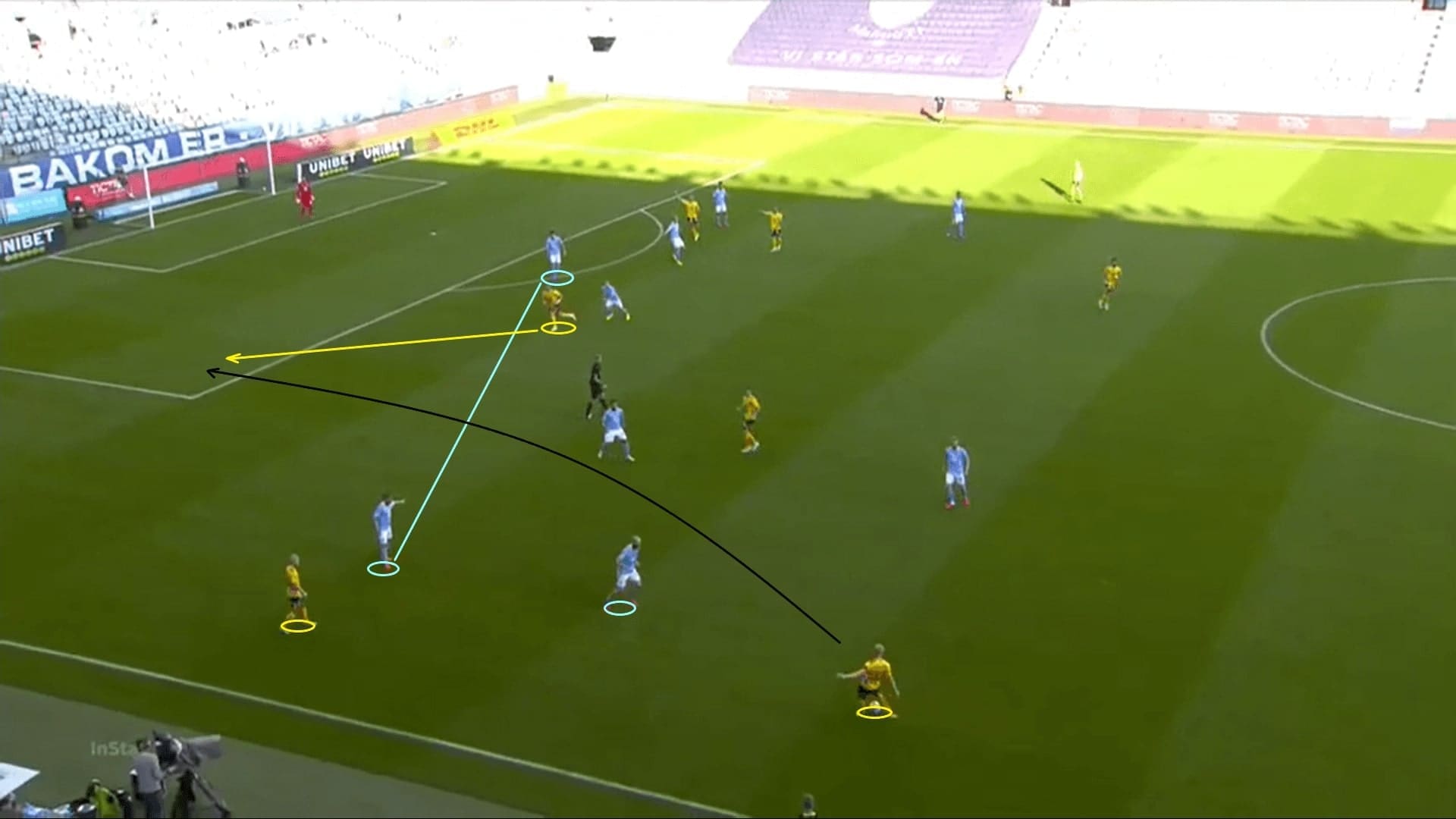
Transitions and second balls
The last part of the analysis covered the transitions and second balls in this game. This is a growing importance factor as the game went on. Malmö came back strong in 45-60 mins, creating a few opportunities from the second balls and counter-attacks. On the other hand, the transitions were also the best chance for Di Gule to create shooting opportunities in the second half, apart from set-plays.
In the second half, Elfsborg more often attacked spaces behind the full-backs in the transitions, especially when Knudsen pushed high to attack. However, the most impressive part of this was the participation of Strand, the left-back of Di Gule. In some cases, the offensive transitions were developing into the counter-attacks, the lightning speed of Strand has catalyzed the process, helping Elfsborg to enter the offensive third.
For example, this example was Strand making a half-space run in the transition. It was a smart move as now E. Larsson was forced to go narrowly, leaving spaces for the wide player to carry on the move.
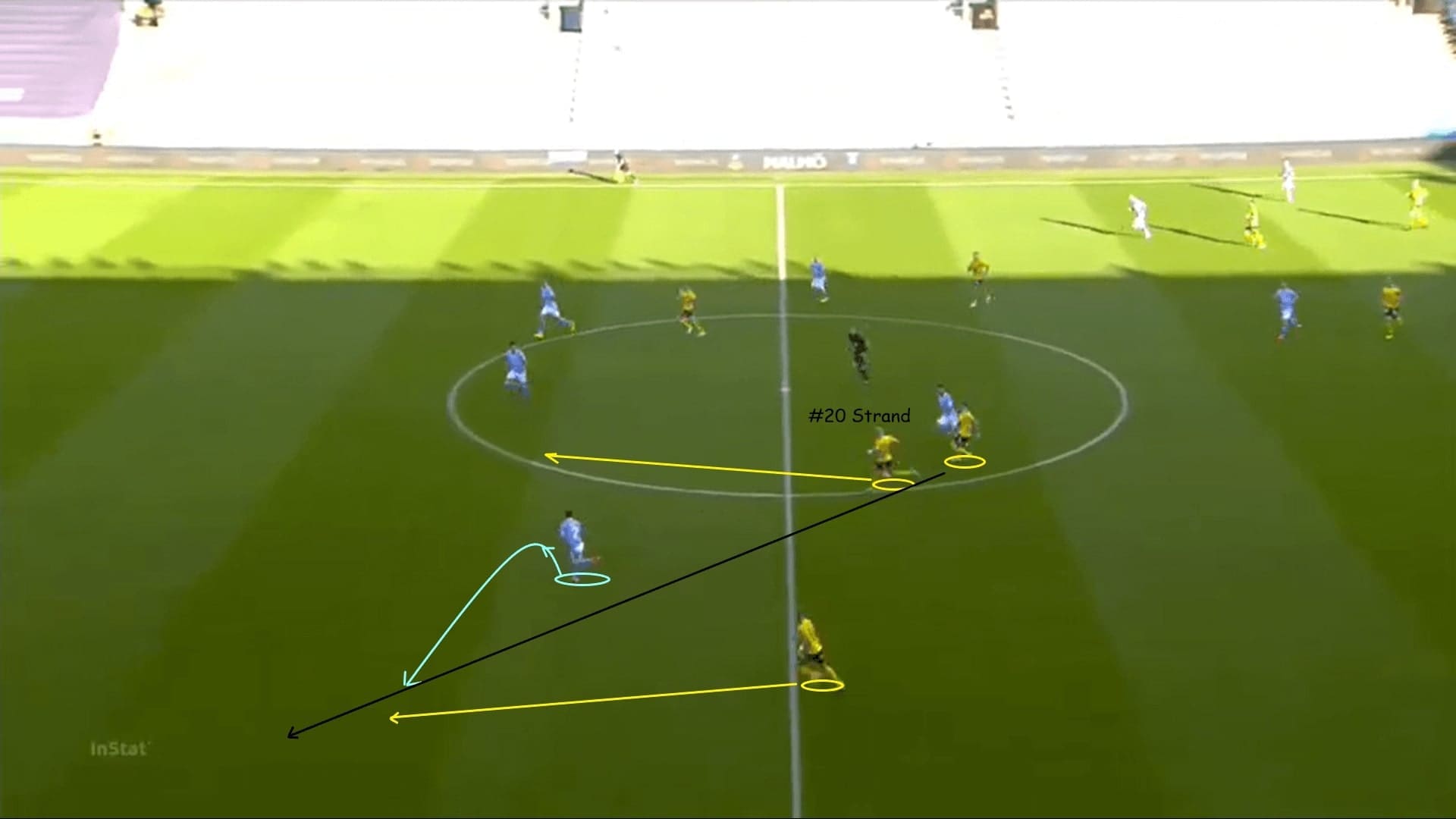
There were also Malmö moments for the counter-attacks. Kiese Thelin was often used as the target man. The striker is smarter now, who was alert of his surroundings, playing quick lay-offs to the third man to attack spaces quickly. This is an improvement compared to those slow decisions when he just returned to Allsvenskan earlier this season.
Elfsborg had to be careful to deal with Kiese Thelin, as the striker possessed physical superiority. If the challenging defender was Väisänen, it was a mismatch. Only Okumu has the aggressiveness and physical quality to deal with Kiese Thelin, which was quite fine in the first half.
However, Elfsborg were a bit sloppy at times in the second half. When playing long, the backline was slow to push higher for the second balls. Without absolute dominance in the air, Malmö had some opportunities after securing the long balls.
In this transition, Kiese Thelin was quickly found, and Okumu was too late to approach the target because of the reason as explained. Okumu still pressed, but the late in timing has allowed Malmö to eliminate the centre-back by one simple pass.
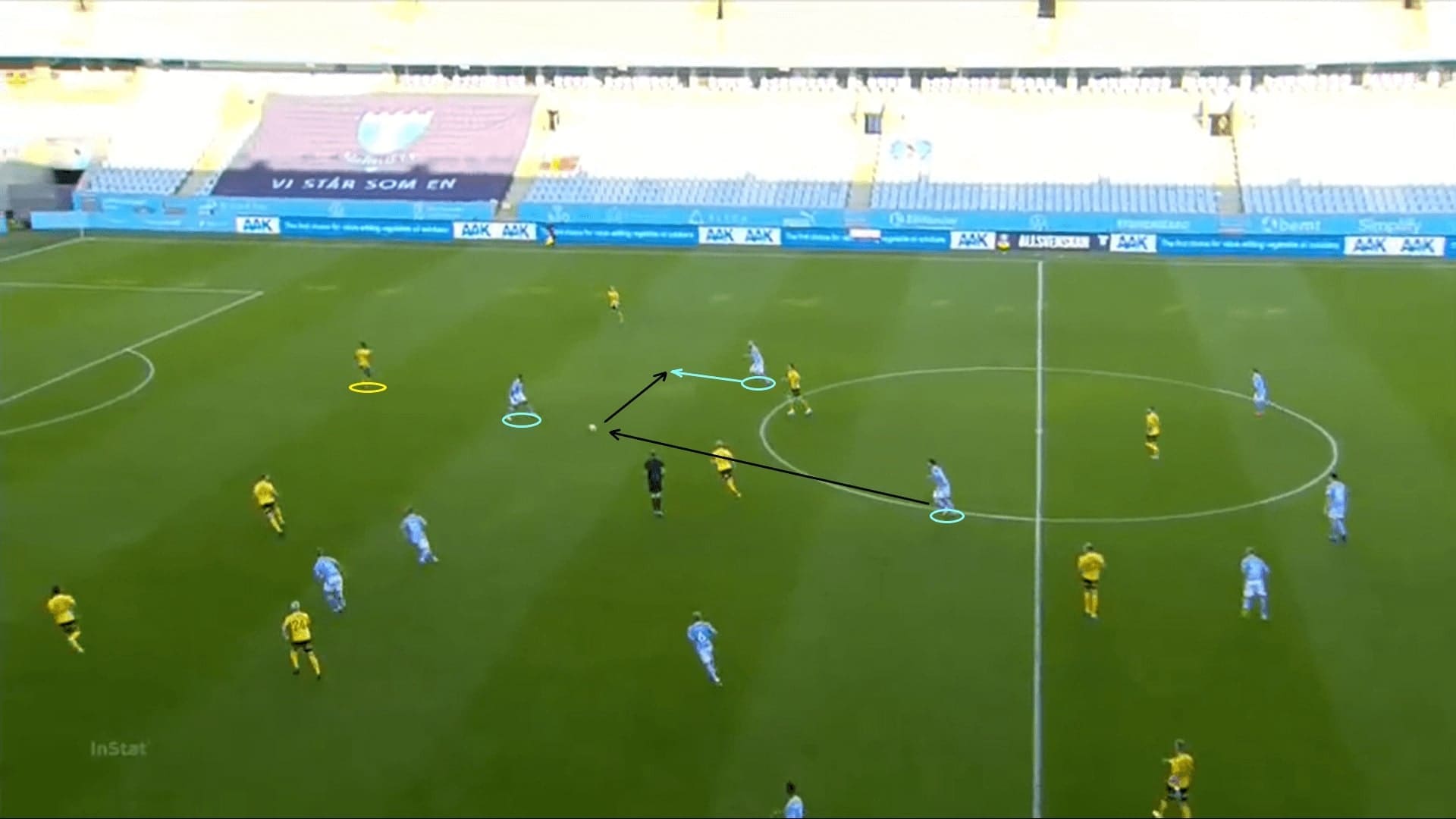
It was another scenario about air battles. Again, the backline was too deep to fight for the second balls, Malmö also capitalized on those opened spaces, picked the ball and counter-attacked.
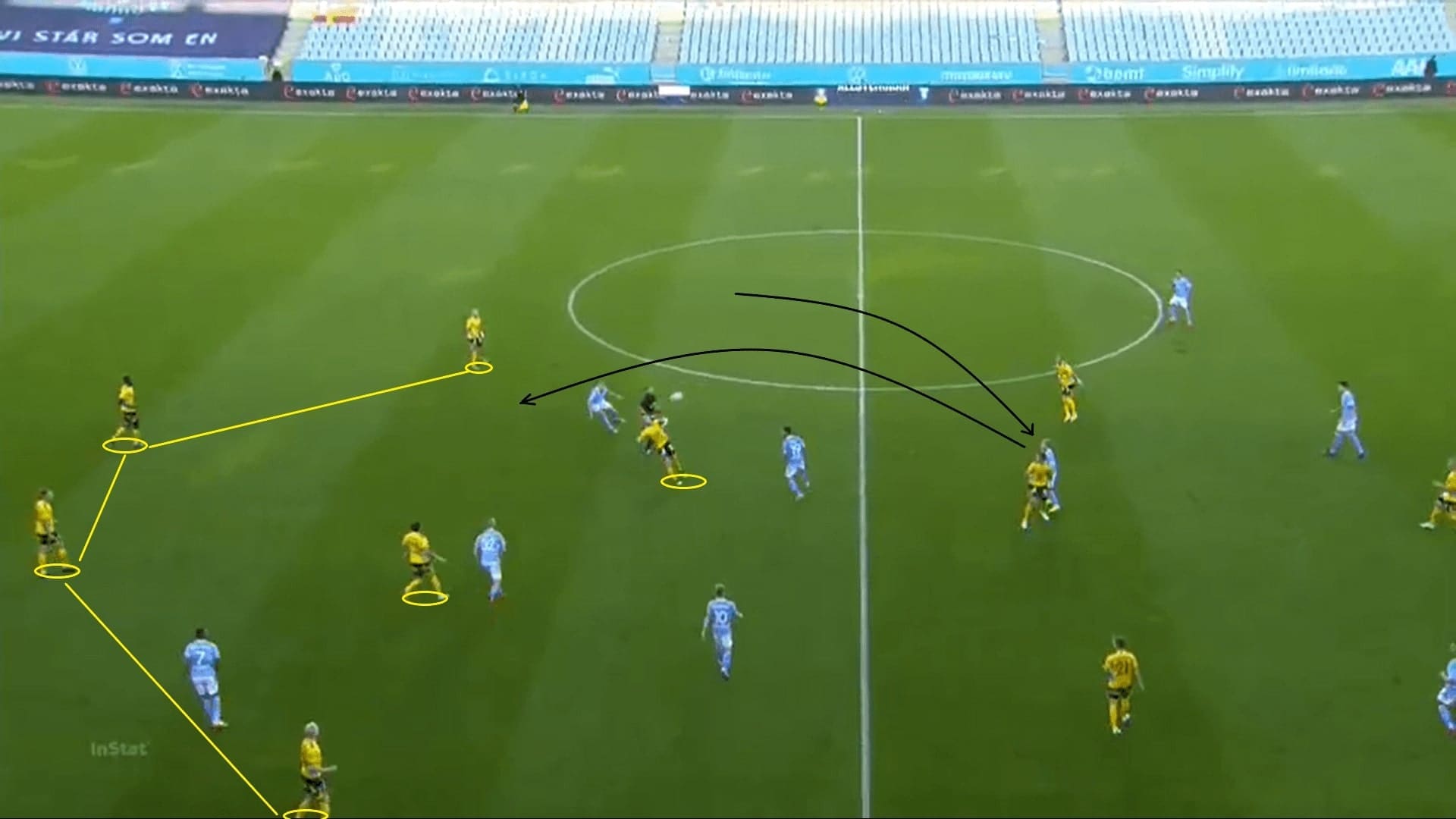
Final remarks
If Malmö won this game, the league might be almost over as the gap with BF Häcken would be eight points, with 12 games remaining. However, neither side take all three points despite created quality chances, the xG statistics – 2.02 vs 2.04 was a fair reflection of the situation.
Tactically, Tomasson has found his way to solve the build-up issue after the uncomfortable first 15-20 minutes. Then, Di blåe looked stronger as the game went on, though there is room for improvements. Allsvenskan is returning nine days later.





Comments